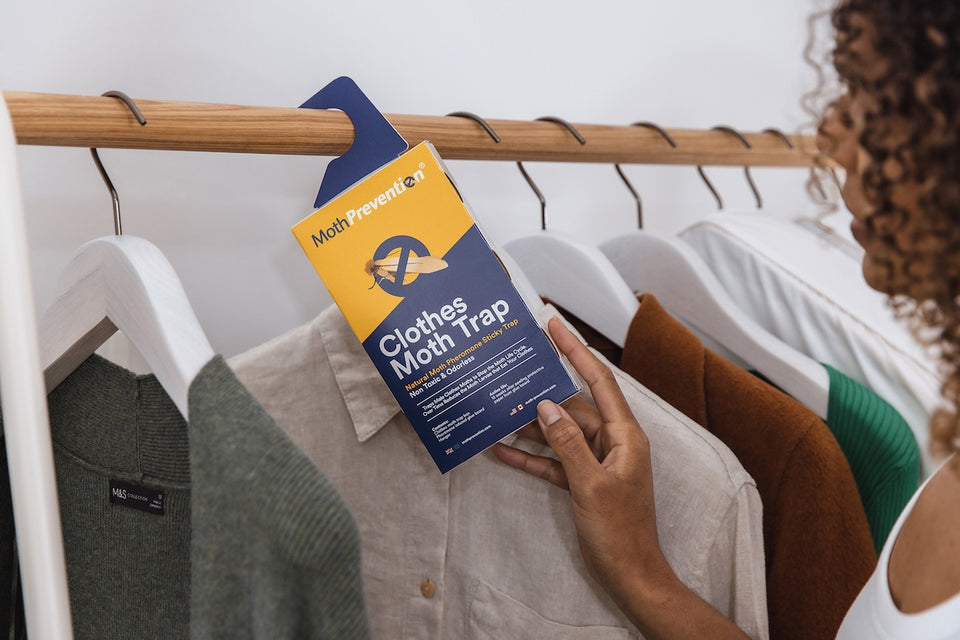How To Get Rid of Closet Moths, Larvae and Eggs

Discovering holes in your favorite clothing can be unsettling. It is often the first visible sign of a clothes moth infestation. The primary species responsible is the Webbing Clothes Moth (Tineola bisselliella), known for laying eggs in dark, quiet spaces where natural animal-based fibers like wool and silk are stored. Once the eggs hatch, the larvae begin feeding on these materials, causing serious and sometimes irreparable damage.
1. Empty Your Closet and Inspect Every Item Thoroughly
Begin by removing everything from the closet. This includes garments, bags, storage containers, shoes, and accessories. Moths thrive in undisturbed areas, so it is important to inspect every item and surface.
Examine garments under good lighting. Focus on seams, cuffs, underarms, waistbands, and folded areas where moth eggs and larvae often hide. Look for small holes in your woolens, cashmere and silks. Moth larvae will also eat leather and feather based fabrics so give these a thorough inspection too. You may also notice silk-like webbing, fine dust, empty casings, or live larvae, which appear cream colored and can be up to one centimetre long.
2. Treat Garments to Kill Moth Eggs and Larvae

Items that show signs of infestation must be treated immediately:
- Dry clean delicate and structured garments. Professional dry cleaning kills all stages of the moth life cycle, including eggs and larvae.
- Freeze affected items that cannot be dry cleaned. Place them in sealed plastic bags and freeze for at least 72 hours. The extreme cold kills larvae and eggs effectively.
- Launder washable items at a high temperature if the fabric allows. Heat is one of the most reliable methods of eradicating moth eggs.
3. Deep Clean the Closet
Vacuum all surfaces in the closet thoroughly. Focus on corners, floorboards, cracks, and shelf joints where moth eggs or larvae may be hidden. After vacuuming, wipe down all hard surfaces with a gentle detergent or a natural cleaning solution to remove remaining debris and residue.
Dispose of the vacuum bag or contents outside the home immediately, as it may contain eggs or larvae.
4. Use Clothes Moth Traps
Place pheromone-based moth traps inside the closet to capture the active adult male moths. These traps disrupt the breeding cycle by preventing males from locating females, which then reduces the number of eggs laid. Traps are also an effective monitoring tool that can alert you to continued moth activity and help you gauge the size of your infestation.

5. Apply Preventative Measures
To avoid reinfestation, implement strong preventative practices:
- Always store freshly cleaned garments. Clothes moth larvae are attracted to animal-based fibers which contain a protein-rich substance called keratin. They will not usually eat cotton or plant-based materials unless they are contaminated with body oils, sweat, food particles, and even pet hair. Unwashed clothes can provide the ideal environment for egg laying and larval feeding.
- Use breathable cotton storage bags. Plastic covers can trap humidity and limit airflow, creating a damp environment that may encourage mold growth and deter fabric from staying fresh. Humidity also provides the perfect breeding conditions for moths so cotton bags which allow ventilation are an ideal storage solution.
- Incorporate natural deterrents. Cedarwood blocks, lavender sachets, or rosemary pouches can help discourage adult moths from settling in storage areas. While not a substitute for traps, these can add an extra layer of defence. However do not place other deterrents near your Moth Traps because this will affect their potency.
- Keep your closet clean and ventilated. A tidy, well-organized wardrobe reduces hiding spots. Regularly vacuum closet floors and wipe down shelving. Open closet doors from time to time to allow air to circulate and light to reach dim corners.
- Monitor regularly. Check traps monthly, especially during spring and early summer when moth activity increases. Even if no moths are visible at the time, keeping the traps in place helps to alert you to early signs of moth presence before serious damage occurs.
6. Continue Monitoring Over Time

Clothes moths go through four life stages: egg, larva, pupa, and adult. This cycle can take anywhere from two months to thirty months depending on how long the larva takes to transform into a cocoon. The life cycle is reliant on temperature, humidity, and availability of food sources. Warmer environments typically speed up development, making regular checks all the more important.
Monitor your traps at least once a month and inspect stored clothing for any signs of new moth activity. Look for small holes, webbing, larvae, or empty cocoons. Rotate stored garments from time to time and keep your closet clean to avoid providing undisturbed hiding places.
If you notice renewed signs of infestation, do not delay. Repeat the complete cleaning and treatment process outlined above. In situations where moths persist despite repeated interventions, consider seeking help from a professional pest control service with experience handling fabric pests. Our Clothes Moth Kit Guide can give you helpful information and advice.
Final Thought
Clothes moths may be small, but their impact on your wardrobe can be significant. With a thorough approach to inspection, treatment, and prevention, you can stop them before they cause lasting damage.
Rely on MothPrevention for proven solutions, trusted by thousands, to eliminate clothes moths and keep your wardrobe protected long term.
About MothPrevention
MothPrevention® speak to customers every day about their clothes moth issues - clothes moths are a species that are ever increasing and that can cause significant damage to clothes, carpets and other home textiles.
To date, we’ve helped over 250,000 customers deal with their moth problems. We have developed professional grade solutions including proprietary pheromones and trap design, not available from anybody else in the USA.





